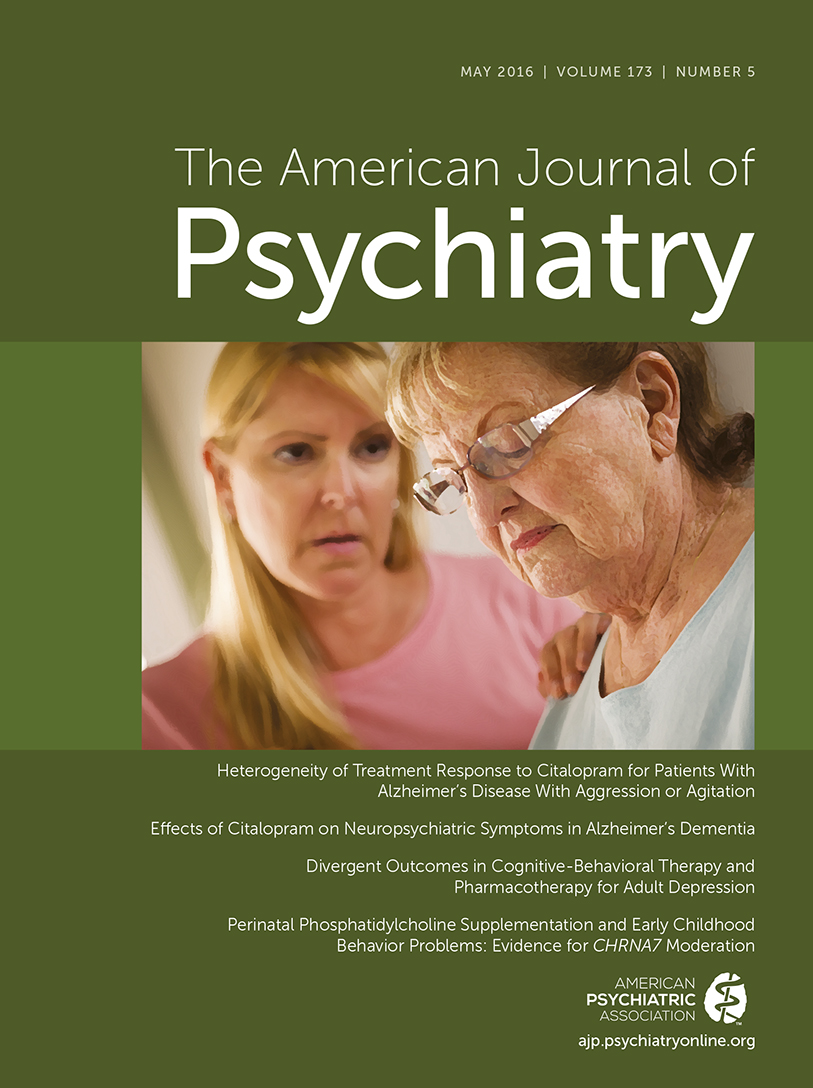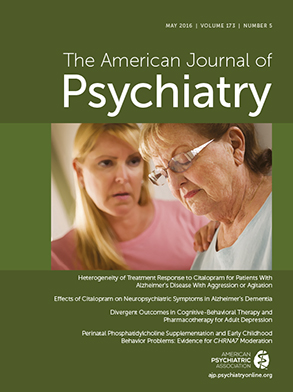Effect sizes for drug interventions in dementia are disappointingly small compared with the changes that psychiatrists are accustomed to seeing when they treat depression or psychosis in their patients who do not have dementia. The lesson from trials of cholinesterase inhibitors and memantine—that these treatments offer improvements in cognition and function that are robustly statistically significant in clinical trials but cannot be reliably detected in an individual patient—also applies to treatments for the non-cognitive symptoms and signs seen in people with dementia. Initial clinical optimism about efficacy of atypical antipsychotics in the management of a wide range of distressing and difficult-to-manage symptoms and behaviors has been dampened by the failure to demonstrate superiority over placebo (
1) and by evidence of severe harms (
2). Risperidone has a license in the European Union for short-term treatment of aggression in dementia, and clinicians make decisions about the use of atypical antipsychotics in this situation based on the presence of psychotic symptoms or consideration of the levels of risk associated with behaviors in an individual patient (
3). But the search for effective and safe drug treatments for psychosis, depression, agitation, aggression, and apathy in dementia is very much ongoing. Given the complexity of the symptoms and behaviors and their individual etiology, involving patient-unique interactions between an impaired brain and an imperfect environment, it should come as no surprise when trials report only modest benefits that, when considered for the average participant in the study, would not be regarded as clinically important (
4). Therefore, emphasis has turned to identifying what characterizes patients who do or do not respond to treatment.
The article by Schneider and colleagues (
5) in this issue reports univariate and two-stage multivariate subgroup analyses from the Citalopram for Agitation in Alzheimer’s Disease (CitAD) trial. These subgroup analyses were conducted to investigate heterogeneity of response among individual trial participants and to identify factors that would predict response to citalopram and placebo. Primary outcome results from the CitAD trial included a mean 0.93-point advantage for citalopram on the 18-point Neurobehavioral Rating Scale agitation subscale and 40% of citalopram participants and 26% of placebo participants showing a moderate or marked improvement from baseline on the Alzheimer Disease Cooperative Study–Clinical Global Impression of Change (
6). Worsening of cognitive function and QT interval prolongation were seen with the high dosage of citalopram used (30 mg/day), and benefits were partly attributable to sedation (
7). For the present study, the authors initially chose 11 individual potential predictors of treatment response (age, gender, residence status, presence of psychosis, functional and cognitive impairment, agitation severity, and use of memantine, lorazepam, trazodone, or a cholinesterase inhibitor within 3 weeks of baseline). Of these, only residence status had a significant effect, so that patients living at home or with relatives showed a significantly greater citalopram effect compared with placebo than patients in long-term care. A post hoc exploratory two-stage multivariate analysis involved five of the 11 baseline factors shown to be the best response predictors (age, residence status, cognitive impairment, agitation severity, and lorazepam use). These baseline covariate values were used to compute an index score for each participant, which was essentially a predicted probability of response with citalopram or placebo treatment. When participants were divided into deciles depending on their index scores, a marked heterogeneity of treatment effect for citalopram compared with placebo across the study population became apparent; Figure 3 in the article is the clearest illustration of this. Essentially, participants in the ninth and 10th deciles (those who were least affected by dementia and had moderate levels of agitation) showed very strong positive response effects for citalopram compared with placebo, and participants in the first decile showed very strong positive response effects for placebo compared with citalopram, while the remaining 70% of participants showed very little in the way of response. Citalopram was most effective in the subgroup of participants who were outpatients, had mild cognitive impairment, had moderate to moderately severe agitation, and were 76–82 years of age. Placebo was most effective (if that is the correct word) in the subgroup who were in long-term care, were oldest (ages 83–92 years) or youngest (ages 47–75 years), had Mini-Mental State Examination scores ≤20, had moderately severe to severe agitation, and used lorazepam.
Although the overall power of the trial was insufficient to draw definitive conclusions as to precisely which agitated and aggressive dementia patients should be treated with citalopram or placebo in practice, demonstration that some participants showed apparently larger benefits and that variation in the size of treatment effect was not random is intriguing. The authors acknowledge that inclusion of participants with a broad range of agitation, aggression, and level of cognitive impairment within the CitAD trial was likely to have led to results that would be difficult to apply in clinical practice. Agitation is an umbrella term for a suite of symptoms and behaviors associated with distress, and consequently it is an ambitious outcome to target in treatment trials. Yet the validity of the items included in the scales designed to measure agitation (e.g., pacing and aimless wandering, constant unwarranted requests for help and attention, trying to get into a different place) (
8) will strike home forcefully with anyone who has been involved in the care of dementia patients and observed or experienced the associated behaviors that cause so much distress to patients and their caregivers. Attempts to operationalize agitation in cognitive disorders (
9) are a potential positive step, although probably still something of an oversimplification of the situation that carries a risk of being most sensitive to nonspecific sedation effects in drug trials.
While clinicians now reluctantly accept that the benefits of Alzheimer’s disease drug treatments on cognition and activities of daily living are only modest for individual patients, they rightly should expect more from a treatment for agitation or aggression in dementia. After all, these symptoms cause immediate distress and place patients and caregivers at risk, and a useful treatment would have to demonstrate a rapid and far more convincing superiority over placebo than has been seen in any of the trials to date. Schneider and colleagues’ identification of a subgroup within the agitation population who appear to show what might be considered a clinically meaningful response to citalopram needs to be explored further and prospectively tested. Perhaps “agitation in dementia” will turn out to be just too nonspecific a target for effective drug treatment. Maybe we will learn—as suggested by this article—that drugs such as citalopram should be used to target a more narrowly characterized group of patients who are relatively young, with mild dementia and high levels of agitation, while those with more severe dementia are more likely to benefit from environmental or behavioral interventions. While it would be premature to abandon agitation and aggression as targets for drug treatments in dementia, future trials should recognize the limitations of these outcomes and could be powered to allow exploration of differential response in participant subgroups.
Although CitAD participants who were randomized to citalopram showed statistically significant improvements on the total Neuropsychiatric Inventory (NPI) score compared with those who received placebo, their scores on the NPI agitation subscale did not improve (
6). Hence, total NPI improvements were driven by changes within the other NPI domains, which include delusions, hallucinations, depression, anxiety, elation, apathy, disinhibition, irritability, aberrant motor behavior, and sleep and eating disorders. Baseline median domain scores for agitation/aggression in the trial population were high (these symptoms were inclusion criteria for the trial), as were scores for aberrant motor behavior, irritability, apathy, and sleep and eating disorders. Although at baseline, delusions were reported in 42% and hallucinations in 21% of the sample, median domain scores for these symptoms were very low, largely because patients with psychosis requiring antipsychotic treatment were excluded from the trial.
In a second article from the CitAD trial in this month’s issue of the
Journal, Leonpacher and colleagues (
10) report the results from the NPI data. The authors explored how each of the individual NPI symptom domains differed between drug and placebo recipients during the trial. By week 9, citalopram-treated participants were significantly less likely to show delusions, anxiety, or irritability and had lower median domain scores for hallucinations than those randomized to placebo. Higher rates of emergence of symptoms in placebo participants during the course of the trial made a contribution to these differences. Thus, between baseline and week 9, delusions emerged in 4% of citalopram and 10% of placebo-treated participants and anxiety in 18% of citalopram and 34% of placebo recipients. Improvements in anxiety and irritability with citalopram would seem intuitive and are consistent with the limited trial literature. But the findings for delusions and hallucinations are more unexpected and interesting. Despite the caveats that these are secondary analyses, that corrections for multiple comparisons weren’t made, and that patients whose psychotic symptoms would normally have indicated antipsychotic treatment were excluded, the results are a further pointer toward serotonergic system dysfunction in psychosis in Alzheimer’s disease (
11). Inclusion in future selective serotonin reuptake inhibitor trials of Alzheimer’s patients with delusions and hallucinations, who would otherwise have been treated with an antipsychotic, is an obvious next step to test the significance of the observations made in this and other studies. Until this has happened, it will be difficult to make useful comment about the clinical practice implications of the results reported by Leonpacher and colleagues in this article.
Just as the conceptualization of “agitation in dementia” may be an oversimplification of a complex spectrum of symptoms and behaviors, our models of anxiety, irritability, delusions, and hallucinations in Alzheimer’s disease, developed and extrapolated from clinical observation and experience with patients who do not have dementia, are far from perfect. Better understanding of the effects of Alzheimer’s neuropathology on activity within central monoamine pathways would help us to design more effective and safe treatments for the distressing and dangerous psychological symptoms and the difficult-to-manage behaviors suffered by our patients and their families. Meanwhile, data from well-designed and carefully reported trials such as CitAD can drive forward an exploration of the best symptoms to target as well as the best drugs to use.

